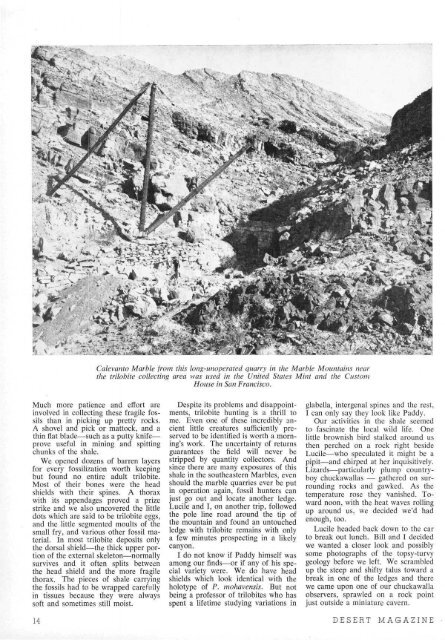HIr - Desert Magazine of the Southwest
HIr - Desert Magazine of the Southwest
HIr - Desert Magazine of the Southwest
Create successful ePaper yourself
Turn your PDF publications into a flip-book with our unique Google optimized e-Paper software.
Calevanto Marble from this long-unoperated quarry in <strong>the</strong> Marble Mountains near<br />
<strong>the</strong> trilobite collecting area was used in <strong>the</strong> United States Mint and <strong>the</strong> Custom<br />
House in San Francisco.<br />
Much more patience and effort are<br />
involved in collecting <strong>the</strong>se fragile fossils<br />
than in picking up pretty rocks.<br />
A shovel and pick or mattock, and a<br />
thin flat blade—such as a putty knife—<br />
prove useful in mining and spitting<br />
chunks <strong>of</strong> <strong>the</strong> shale.<br />
We opened dozens <strong>of</strong> barren layers<br />
for every fossilization worth keeping<br />
but found no entire adult trilobite.<br />
Most <strong>of</strong> <strong>the</strong>ir bones were <strong>the</strong> head<br />
shields with <strong>the</strong>ir spines. A thorax<br />
with its appendages proved a prize<br />
strike and we also uncovered <strong>the</strong> little<br />
dots which are said to be trilobite eggs,<br />
and <strong>the</strong> little segmented moults <strong>of</strong> <strong>the</strong><br />
small fry, and various o<strong>the</strong>r fossil material.<br />
In most trilobite deposits only<br />
<strong>the</strong> dorsal shield—<strong>the</strong> thick upper portion<br />
<strong>of</strong> <strong>the</strong> external skeleton—normally<br />
survives and it <strong>of</strong>ten splits between<br />
<strong>the</strong> head shield and <strong>the</strong> more fragile<br />
thorax. The pieces <strong>of</strong> shale carrying<br />
<strong>the</strong> fossils had to be wrapped carefully<br />
in tissues because <strong>the</strong>y were always<br />
s<strong>of</strong>t and sometimes still moist.<br />
Despite its problems and disappointments,<br />
trilobite hunting is a thrill to<br />
me. Even one <strong>of</strong> <strong>the</strong>se incredibly ancient<br />
little creatures sufficiently preserved<br />
to be identified is worth a morning's<br />
work. The uncertainty <strong>of</strong> returns<br />
guarantees <strong>the</strong> field will never be<br />
stripped by quantity collectors. And<br />
since <strong>the</strong>re are many exposures <strong>of</strong> this<br />
shale in <strong>the</strong> sou<strong>the</strong>astern Marbles, even<br />
should <strong>the</strong> marble quarries ever be put<br />
in operation again, fossil hunters can<br />
just go out and locate ano<strong>the</strong>r ledge.<br />
Lucile and I, on ano<strong>the</strong>r trip, followed<br />
<strong>the</strong> pole line road around <strong>the</strong> tip <strong>of</strong><br />
<strong>the</strong> mountain and found an untouched<br />
ledge with trilobite remains with only<br />
a few minutes prospecting in a likely<br />
canyon.<br />
I do not know if Paddy himself was<br />
among our finds—or if any <strong>of</strong> his special<br />
variety were. We do have head<br />
shields which look identical with <strong>the</strong><br />
holotype <strong>of</strong> P. mohavensis. But not<br />
being a pr<strong>of</strong>essor <strong>of</strong> trilobites who has<br />
spent a lifetime studying variations in<br />
glabella, intergenal spines and <strong>the</strong> rest,<br />
I can only say <strong>the</strong>y look like Paddy.<br />
Our activities in <strong>the</strong> shale seemed<br />
to fascinate <strong>the</strong> local wild life. One<br />
little brownish bird stalked around us<br />
<strong>the</strong>n perched on a rock right beside<br />
Lucile—who speculated it might be a<br />
pipit—and chirped at her inquisitively.<br />
Lizards—particularly plump countryboy<br />
chuckawallas — ga<strong>the</strong>red on surrounding<br />
rocks and gawked. As <strong>the</strong><br />
temperature rose <strong>the</strong>y vanished. Toward<br />
noon, with <strong>the</strong> heat waves rolling<br />
up around us, we decided we'd had<br />
enough, too.<br />
Lucile headed back down to <strong>the</strong> car<br />
to break out lunch. Bill and I decided<br />
we wanted a closer look and possibly<br />
some photographs <strong>of</strong> <strong>the</strong> topsy-turvy<br />
geology before we left. We scrambled<br />
up <strong>the</strong> steep and shifty talus toward a<br />
break in one <strong>of</strong> <strong>the</strong> ledges and <strong>the</strong>re<br />
we came upon one <strong>of</strong> our chuckawalla<br />
observers, sprawled on a rock point<br />
just outside a miniature cavern.<br />
14 DESERT MAGAZINE

















